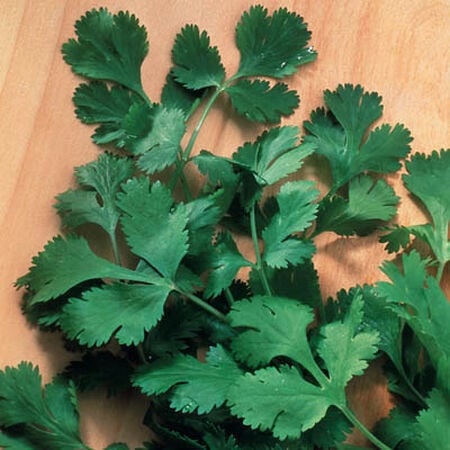Slow Bolt, Cilantro Seeds
Key Attributes
Key Attributes
Product Details
Weight
0.009Depth
0.2Height
4.5Width
3.25Plant Height
12-24"Botanical Name
Coriandrum sativumSeed Type
SeedSeeds Per Gram
90Seeds Per Pound
39,900Packet
100 SeedsSow Depth
1/4"Seeds Per Ounce
4,475Breed
Open-pollinatedSun
Partial ShadeGrowing Conditions
Container FriendlyLife Cycle
AnnualSow Method
Direct SowTransplantCategories
HerbGermination
11,12,13,14,8,9,10Days To Maturity (# Days)
50Components
Growing Instructions
![]() Learning Download: How to Grow Cilantro
Learning Download: How to Grow Cilantro
Cilantro is a popular herb grown to be used in Mexican and Asian Dishes. The edible leaves of the plant are called cilantro, and the seed, which is also edible, is called coriander.
Before Planting: Prior to planting the seeds, you must prepare them so they will be able to germinate. Coriander seeds are actually two seeds encased in a husk. Crush the husk gently by holding the two seeds together and then soak the seeds in water for 24 to 48 hours. Remove the seeds from the water and allow them to dry prior to planting.
Planting: Cilantro can be started indoors or outdoors. Plant the seeds ¼ inch deep. To transplant a cilantro plant
that has been started indoors, dig holes 3 to 4 inches apart in the garden. After transplanting, water the cilantro thoroughly.
Watering: Water regularly, but be careful not to over-water the plant as it could create yellow leaves. To prevent leaf spot, make sure the plant is in well-drained soil.
Fertilizer: During its first few weeks of life, cilantro grows well if a water-soluble fertilizer is applied. Fertilize with a
water-soluble fertilizer every other time you water the plant. Once flowers appear and the plant begins to go to seed, stop fertilizing.
Days to Maturity: Cilantro is ready to harvest within 45 days.
Harvesting: Cut the upper new leaves to harvest. Unlike other herbs, cilantro is rarely frozen and used later in cooking as it loses almost all of its scent and flavor if not fresh.
Tips: Cilantro likes full sun, but in hotter climates, partial shade will be tolerated as the plant bolts in warm weather.
Shipping Schedule
Our Seed Promise
 "Agriculture and seeds" provide the basis upon which our lives depend. We must protect this foundation as a safe and genetically stable source for future generations. For the benefit of all farmers, gardeners and consumers who want an alternative, we pledge that we do not knowingly buy or sell genetically engineered seeds or plants.
"Agriculture and seeds" provide the basis upon which our lives depend. We must protect this foundation as a safe and genetically stable source for future generations. For the benefit of all farmers, gardeners and consumers who want an alternative, we pledge that we do not knowingly buy or sell genetically engineered seeds or plants.
The mechanical transfer of genetic material outside of natural reproductive methods and between genera, families or kingdoms, poses great biological risks as well as economic, political, and cultural threats. We feel that genetically engineered varieties have been insufficiently tested prior to public release. More research and testing is necessary to further assess the potential risks of genetically engineered seeds. Further, we wish to support agricultural progress that leads to healthier soils, to genetically diverse agricultural ecosystems, and ultimately to healthy people and communities.
To learn more about the "Safe Seed Pledge" please visit www.councilforresponsiblegenetics.org.

